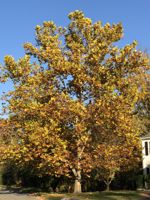Mon-Fri 9am - 5pm Mountain time
Black Locust vs American Sycamore
Robinia pseudoacacia
Platanus occidentalis
NOT AVAILABLE THIS SEASON - MIGHT RETURN
Black Locust is an attractive tree. Its distinctive leaves are made of about a dozen bright green leaflets. It also notable for its fragrant white flowers, which smell of citrus.
Black Locust can grow in many situations, but prefers dry areas with lots of sun. It is robust and is an excellent choice for establishing shade in dry, open areas.
Important note: Much of the Black Locust is toxic to humans and livestock, including seeds, bark, and leaves.
American Sycamore is the largest tree native to eastern North America. Generally too large and messy to be a street tree, American Sycamore thrives in large, open spaces, such as an acreage or farm.
The bark is one of the main features that draw people to this tree. The outer bark flakes off in irregular pieces to reveal an attractive white, green, and cream colored inner layer, providing winter interest.
American Sycamore has an extremely fast growth rate, gaining up to 6 ft in one year, and will easily reach its mature height in a short period of time. Be wary of this trees' root system, as it's typically very extensive and needs lots of room to expand.

